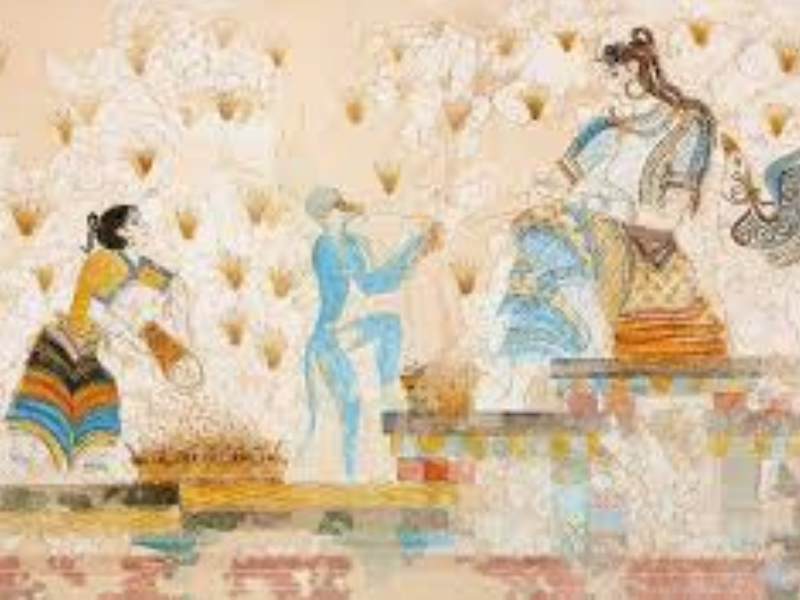Table of Contents
I. Introduction
In the shimmering waters of the Aegean Sea lies the island of Crete, the cradle of the Minoan Civilization. Flourishing during the Bronze Age, circa 2600–1100 BC, this civilization is renowned for its distinct cultural identity.
However, beneath its unique surface, the Minoans were deeply influenced by external titans of the ancient world – the cultures of the Near East and Egypt. These intercultural exchanges were pivotal, shaping the very essence of Minoan life, from their grand architectural endeavors to the intricacies of their administrative systems and the depths of their artistic expressions.
In this exploration, we delve into the heart of these influences, unraveling how external cultures molded and enriched the Minoan way of life. From the monumental architecture echoing the grandiosity of the East to the administrative prowess reflecting Egyptian sophistication, the Minoans absorbed and reinterpreted these influences, weaving them into the fabric of their own society.
II. Architectural Marvels: Near Eastern and Egyptian Impressions
The architectural landscape of Minoan Crete is a testament to the profound impact of the Near East and Egypt. This influence is most prominently showcased in the Minoan palaces, with the Palace of Knossos standing as the crowning jewel.
These palatial structures, with their complex layouts and elaborate designs, draw parallels with the monumental architecture of these ancient regions. The advanced architectural techniques, possibly derived from Eastern models, contributed to the creation of aesthetically magnificent and functionally sophisticated Minoan palaces.

III. Administrative Systems: The Echoes of Egypt
In the realm of administration, the influence of Egypt on the Minoans was particularly pronounced. The intricate administrative apparatus of Minoan palaces, with their complex hierarchy and methodical record-keeping, bears a striking resemblance to the bureaucratic practices of ancient Egypt.
The Minoans utilized clay tablets for writing, paralleling Egyptian methods, which facilitated intricate administrative tasks and governance. This adoption reflects a sophisticated approach to administration, indicative of a society striving for efficiency and order, inspired by the established systems of the Nile Valley.
IV. Artistic Convergence: Frescoes and Iconography
The Minoan Civilization’s artistic heritage, especially in fresco art, is a vibrant tapestry interwoven with threads from the Near East and Egypt. The frescoes adorning the walls of Minoan palaces are not mere decorations; they are narratives and symbolisms, some of which find their roots in Eastern art.
The iconographic themes and the organization of these frescoes suggest a profound blend of Minoan creativity with Eastern artistic traditions, creating a unique, yet familiar, visual language. From the lively, naturalistic depictions of nature and society to the sacred motifs that often mirrored Eastern symbolism, the frescoes served as a canvas where international influences and local artistry met and mingled.
V. Craftsmanship and Metallurgy: Levantine Influences
The craftsmanship and metallurgical expertise of the Minoan artisans were significantly honed by the influence of the southern Levant. The renowned Minoan metalwork, particularly in gold, might have been shaped by the techniques and artistry of Levantine goldsmiths.
Artifacts like the Bee Pendant from the Malia cemetery and the acrobat-depicting golden sword pommel echo this cross-cultural blend of artistry. These items not only display the technical skill and aesthetic sense of Minoan craftspeople but also reveal the subtle infusion of Near Eastern artistic styles, marrying indigenous creativity with foreign expertise.
VI. Intangible Cultural Exchanges
Beyond the tangible exchanges of goods and artistic techniques, the intangible aspects of Minoan interactions with the Near East and Egypt played a vital role. The Minoan worldview, characterized by a profound appreciation for nature, beauty, elegance, and a certain level of sophistication, found resonance in foreign lands.
These intangible elements, encompassing philosophical concepts, aesthetics, and lifestyle choices, permeated various facets of Minoan life, influencing their rituals, daily practices, and even philosophical outlooks. Such exchanges underscored the depth of Minoan interactions with these ancient civilizations, extending beyond mere trade and into the realms of cultural and intellectual exchange.
VII. Conclusion
The influence of the Near East and Egypt on the Minoan Civilization is a tale of profound and pervasive cultural exchange. These external forces shaped the architectural feats, administrative sophistication, and artistic endeavors of the Minoans, contributing significantly to the unique character of this ancient civilization.
The Minoans, while absorbing these influences, were not merely passive recipients; they reinterpreted and integrated them into their own culture, creating a distinct Minoan identity enriched by foreign elements.
This synthesis of influences speaks to the interconnected nature of ancient civilizations. The Minoans, far from being isolated on their Aegean island, were active participants in a vibrant intercultural dialogue. Their civilization, a blend of local ingenuity and external inspirations, stands as a testament to the dynamic cultural exchanges of the ancient world.
Understanding these cross-cultural interactions is crucial for a comprehensive appreciation of Minoan society. It reveals a civilization that was as much a product of its own creativity and resourcefulness as it was of the echoes from the East.
The legacy of the Minoan Civilization, therefore, is not just in the ruins of its palaces or the fragments of its frescoes, but also in its role as a conduit and crucible for cultural fusion in the Bronze Age Mediterranean.


